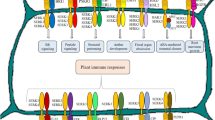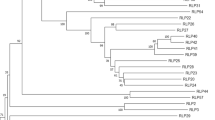Abstract
A leucine-rich repeat receptor-like kinase (LRR-RLK) encoded by one of the genes highly expressed in a specific stage of soybean seed development, referred to as GmLRK1, was identified and characterized. Examination of its kinase domain indicated that GmLRK1 may be a catalytically inactive atypical receptor kinase. An autophosphorylation assay confirmed that GmLRK1 is incapable of autophosphorylation in vitro. However, the phosphorylation of GmRLK1 could be induced after incubation with plant protein extracts, suggesting that some plant proteins may interact with GmLRK1 and phosphorylate the protein in vivo. Analyses of the expression profiles of GmLRK1 and its Arabidopsis ortholog At2g36570 revealed that they may be involved in regulation of more fundamental metabolic and/or developmental pathways, rather than a specialized developmental program such as seed development. Our results further indicate that the GmLRK1 and At2g36570 may play a role in the regulation of certain cellular processes that lead to cell elongation and expansion.






Similar content being viewed by others
Abbreviations
- DEGs:
-
Differentially expressed genes
- LRR-RLK:
-
Leucine-rich repeat receptor-like kinase
- GmLRK1:
-
Glycine max leucine-rich repeat receptor-like kinase 1
- GST:
-
Glutathione S-transferase
References
Beeckman T, Przemeck GK, Stamatiou G, Lau R, Terryn N, De Rycke R, Inze D, Berleth T (2002) Genetic complexity of cellulose synthase a gene function in Arabidopsis embryogenesis. Plant Physiol 130:1883–1893
Cao X, Li K, Suh SG, Guo T, Becraft PW (2005) Molecular analysis of the CRINKLY4 gene family in Arabidopsis thaliana. Planta 220:645–657
Castells E, Casacuberta JM (2007) Signalling through kinase-defective domains: the prevalence of atypical receptor-like kinases in plants. J Exp Bot 58:3503–3511
Chevalier D, Batoux M, Fulton L, Pfister K, Yadav RK, Schellenberg M, Schneitz K (2005) STRUBBELIG defines a receptor kinase-mediated signaling pathway regulating organ development in Arabidopsis. Proc Natl Acad Sci USA 102:9074–9079
Chu Z, Chen H, Zhang Y, Zhang Z, Zheng N, Yin B, Yan H, Zhu L, Zhao X, Yuan M, Zhang X, Xie Q (2007) Knockout of the AtCESA2 gene affects microtubule orientation and causes abnormal cell expansion in Arabidopsis. Plant Physiol 143:213–224
Clark SE, Running MP, Meyerowitz EM (1993) CLAVATA1, a regulator of meristem and flower development in Arabidopsis. Development 119:397–418
Clouse SD, Langford M, Mcmorris TC (1996) A brassinosteroid-insensitive mutant in Arabidopsis thaliana exhibits multiple defects in growth and development. Plant Physiol 111:671–678
Cock JM, Vanoosthuyse V, Gaude T (2002) Receptor kinase signalling in plants and animals: distinct molecular systems with mechanistic similarities. Curr Opin Cell Biol 14:230–236
Desprez T, Vernhettes S, Fagard M, Refregier G, Desnos T, Aletti E, Py N, Pelletier S, Hofte H (2002) Resistance against herbicide isoxaben and cellulose deficiency caused by distinct mutations in same cellulose synthase isoform CESA6. Plant Physiol 128:482–490
Endre G, Kereszt A, Kevei Z, Muhacea S, Kalo P, Kiss GB (2002) A receptor kinase gene regulating symbiotic nodule development. Nature 417:962–966
Fagard M, Desnos T, Desprez T, Goubet F, Refregier G, Mouille G, McCann M, Rayon C, Vernhettes S, Hofte H (2000) PROCUSTE1 encodes a cellulose synthase required for normal cell elongation specifically in roots and dark-grown hypocotyls of Arabidopsis. Plant Cell 12:2409–2424
Fehr WR, Caviness CE, Burmood DT, Pennington JS (1971) Stages of development descriptions for soybeans, Glycine max (L.) Merill. Crop Sci 11:929–931
Finn RD, Mistry J, Schuster-Bockler B, Griffiths-Jones S, Hollich V, Lassmann T, Moxon S, Marshall M, Khanna A, Durbin R, Eddy SR, Sonnhammer EL, Bateman A (2006) Pfam: clans, web tools and services. Nucleic Acids Res 34:D247–D251
Gómez-Gómez L, Boller T (2000) FLS: an LRR receptor-like kinase involved in the perception of the bacterial elicitor flagellin in Arabidopsis. Mol Cell 5:1003–1011
Hajduch M, Ganapathy A, Stein JW, Thelen JJ (2005) A systematic proteomic study of seed filling in soybean. Establishment of high-resolution two-dimensional reference maps, expression profiles, and an interactive proteome database. Plant Physiol 137:1397–1419
Hanks SK, Hunter T (1995) Protein kinases 6. The eukaryotic protein kinase superfamily: kinase (catalytic) domain structure and classification. FASEB J 9:576–596
Hanks SK, Quinn AM, Hunter T (1988) The protein kinase family: conserved features and deduced phylogeny of the catalytic domains. Science 241:42–52
Hao L, Wang H, Sunter G, Bisaro DM (2003) Geminivirus AL2 and L2 proteins interact with and inactivate SNF1 kinase. Plant Cell 15:1034–1048
Hecht V, Vielle-Calzada JP, Hartog MV, Schmidt ED, Boutilier K (2001) The Arabidopsis Somatic Embryogenesis Receptor Kinase 1 gene expressed in developing ovules and embryos and enhances embryogenic compteenece in culture. Plant Physiol 127:803–816
Heim DR, Skomp JR, Tschabold EE, Larrinua IM (1990) Isoxaben inhibits the synthesis of acid insoluble cell wall materials in Arabidopsis thaliana. Plant Physiol 93:695–700
Hematy K, Sado PE, Van Tuinen A, Rochange S, Desnos T, Balzergue S, Pelletier S, Renou JP, Hofte H (2007) A receptor-like kinase mediates the response of Arabidopsis cells to the inhibition of cellulose synthesis. Curr Biol 17:922–931
Ito T, Motohashi R, Kuromori T, Mizukado S, Sakurai T, Kanahara H, Seki M, Shinozaki K (2002) A new resource of locally transposed dissociation elements for screening gene-knockout lines in silico on the Arabidopsis genome. Plant Physiol 129:1695–1699
Johnson KL, Ingram GC (2005) Sending the right signals: regulating receptor kinase activity. Curr Opin Plant Biol 8:648–656
Kim HH, Vijapurkar U, Hellyer NJ, Bravo D, Koland JG (1998) Signal transduction by epidermal growth factor and heregulin via the kinase-deficient ErbB3 protein. Biochem J 334:189–195
Kim YJ, Kwak CI, Gu YY, Hwang IT, Chun JY (2004) Annealing control primer system for identification of differentially expressed genes on agarose gels. Biotechniques 36:424–426, 428, 430 passim
Kim YK, Son O, Kim MR, Nam KH, Kim GT, Lee MS, Choi SY, Cheon CI (2007) ATHB23, an Arabidopsis class I homeodomain-leucine zipper gene, is expressed in the adaxial region of young leaves. Plant Cell Rep 26:1179–1185
Knighton DR, Cadena DL, Zheng J, Ten Eyck LF, Taylor SS, Sowadski JM, Gill GN (1993) Structural features that specify tyrosine kinase activity deduced from homology modeling of the epidermal growth factor receptor. Proc Natl Acad Sci USA 90:5001–5005
Kuromori T, Hirayama T, Kiyosue Y, Takabe H, Mizukado S, Sakurai T, Akiyama K, Kamiya A, Ito T, Shinozaki K (2004) A collection of 11,800 single-copy Ds transposon insertion lines in Arabidopsis. Plant J 37:897–905
Le BH, Wagmaister JA, Kawashima T, Bui AQ, Harada JJ, Goldberg RB (2007) Using genomics to study legume seed development. Plant Physiol 144:562–574
Lee MY, Shin KH, Kim YK, Suh JY, Gu YY, Kim MR, Hur YS, Son O, Kim JS, Song E, Lee MS, Nam KH, Hwang KH, Sung MK, Kim HJ, Chun JY, Park M, Ahn TI, Hong CB, Lee SH, Park HJ, Park JS, Verma DP, Cheon CI (2005) Induction of thioredoxin is required for nodule development to reduce reactive oxygen species levels in soybean roots. Plant Physiol 139:1881–1889
Letunic I, Copley RR, Pils B, Pinkert S, Schultz J, Bork P (2006) SMART 5: domains in the context of genomes and networks. Nucleic Acids Res 34:D257–D260
Li Y, Fang H, Xu W (2007) Recent advance in the research of flavonoids as anticancer agents. Mini Rev Med Chem 7:663–678
Llompart B, Castells E, Rio A, Roca R, Ferrando A, Stiefel V, Puigdomenech P, Casacuberta JM (2003) The direct activation of MIK, a germinal center kinase (GCK)-like kinase, by MARK, a maize atypical receptor kinase, suggests a new mechanism for signaling through kinase-dead receptors. J Biol Chem 278:48105–48111
Mahfouz MM, Kim S, Delauney AJ, Verma DP (2006) Arabidopsis TARGET OF RAPAMYCIN interacts with RAPTOR, which regulates the activity of S6 kinase in response to osmotic stress signals. Plant Cell 18:477–490
Morillo SA, Tax FE (2006) Functional analysis of receptor-like kinases in monocots and dicots. Curr Opin Plant Biol 9:460–469
Morris ER, Walker JC (2003) Receptor-like protein kinases: the keys to response. Curr Opin Plant Biol 6:339–342
Oh HS, Son O, Chun JY, Stacey G, Lee MS, Min KH, Song ES, Cheon CI (2001) The Bradyrhizobium japonicum hsfA gene exhibits a unique developmental expression pattern in cowpea nodules. Mol Plant Microbe Interact 14:1286–1292
Powles T (2004) Isoflavones and women’s health. Breast Cancer Res 6:140–142
Rudrabhatla P, Reddy MM, Rajasekharan R (2006) Genome-wide analysis and experimentation of plant serine/threonine/tyrosine-specific protein kinases. Plant Mol Biol 60:293–319
Scheible WR, Eshed R, Richmond T, Delmer D, Somerville C (2001) Modifications of cellulose synthase confer resistance to isoxaben and thiazolidinone herbicides in Arabidopsis Ixr1 mutants. Proc Natl Acad Sci USA 98:10079–10084
Shiu SH, Bleecker AB (2001) Receptor-like kinases from Arabidopsis form a monophyletic gene family related to animal receptor kinases. Proc Natl Acad Sci USA 98:10763–10768
Song WY, Wang GL, Cheon LL, Kim HS, Pi LY, Holstem T, Wang B, Zhai W, Zhu LH, Fauquet C, Ronald P (1995) A receptor kinase-like protein encoded by the rice disease resistance gene, Xa21. Science 270:1804–1806
Stracke S, Kistner C, Yoshida S, Mulder L, Sato S, Kaneko T, Sandal N, Stougaard J, Szcxyglowski K, Parniske M (2002) A plant receptor-like kinase requied for both bacterial and fungal symbiosis. Nature 417:959–962
Sugden C, Crawford RM, Halford NG, Hardie DG (1999) Regulation of spinach SNF1-related (SnRK1) kinases by protein kinases and phosphatases is associated with phosphorylation of the T loop and is regulated by 5′-AMP. Plant J 19:433–439
Torii KU (2004) Leucine-rich repeat receptor kinases in plants: structure, function, and signal transduction pathways. Int Rev Cytol 234:1–46
Valon C, Smalle J, Goodman HM, Giraudat J (1993) Characterization of an Arabidopsis thaliana gene (TMKL1) encoding a putative transmembrane protein with an unusual kinase-like domain. Plant Mol Biol 23:415–421
Wilcox J (2004) World distribution and trade of soybean. In: Boerma R, Specht J (eds) Soybens: improvement, production and uses. American Society of Agronomy, Madison, pp 1–14
Yamamoto E, Knap HT (2001) Soybean receptor-like protein kinase genes: paralogous divergence of a gene family. Mol Biol Evol 18:1522–1531
Zimmermann P, Hirsch-Hoffmann M, Hennig L, Gruissem W (2004) GENEVESTIGATOR. Arabidopsis microarray database and analysis toolbox. Plant Physiol 136:2621–2632
Acknowledgments
We thank Dr. David Bisaro (Ohio State University) for providing us with the GST-AtSnRK-CD construct and RIKEN Genomic Science Center for the transposon-tagged mutant AtLRK1seeds. This study was supported by a grant (No. 305005-4) from the Technology Development Program of the Ministry of Agriculture and Forestry.
Author information
Authors and Affiliations
Corresponding author
Additional information
S. Kim and S.-J. Kim have contributed equally to this work.
Rights and permissions
About this article
Cite this article
Kim, S., Kim, SJ., Shin, YJ. et al. An atypical soybean leucine-rich repeat receptor-like kinase, GmLRK1, may be involved in the regulation of cell elongation. Planta 229, 811–821 (2009). https://doi.org/10.1007/s00425-008-0873-3
Received:
Accepted:
Published:
Issue Date:
DOI: https://doi.org/10.1007/s00425-008-0873-3




